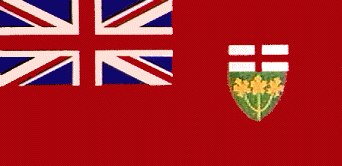|
|
|
Ontario |
 |
|
The LandThe name "Ontario" comes from the Iroquois word "Kanadario" meaning "sparkling water." The name is fitting: not only is Ontario bordered on the south by the Great Lakes and on the north by Hudson Bay, but 177 390 km2, or one sixth of its terrain, is covered by rivers and lakes. Three main geological regions make up Ontario: the Great Lakes-St. Lawrence Lowlands, the Canadian Shield and the Hudson Bay Lowlands. The latter are narrow coastal plains bordering Hudson Bay and James Bay; the land is wet and covered by scrub growth. The Canadian Shield, covering the rest of northern Ontario from Lake Superior to Hudson Bay and extending into the southern part of the province, is a vast rocky plateau. Although the soil is poor and not well suited to large-scale farming, there is a wealth of minerals, forests and water power. The Canadian Shield and the Hudson Bay Lowlands cover 90 percent of the province's 1 068 580 km2 of territory, but are home to only 10 percent of the population. Although the fur trade was the original catalyst for development in Northern Ontario, many towns in the northern part of the province were built because of the railway, and today rails and roads carry the products of the mines and lumber mills southward. Farther north, travel is often limited to air and water. The extremes of the northern climate are a fact of life there. At Winisk, mean daily temperatures reach only 12 to 15°C in July, dropping to minus 25°C in January. The five Great Lakes are the most visible results of the ice age in Ontario, and the biggest, Lake Superior, is the world's largest body of fresh water. The Great Lakes-St. Lawrence Lowlands make up the rest of southern Ontario and contain most of the population, industry, commerce and agricultural lands. The Lowlands include the Windsor-Thousand Islands-St. Lawrence Valley triangle. Mean annual summer temperatures reach 22°C in the south, where the temperate climate and fertile soils nurture a major agricultural industry. This relatively small area has more than half of Canada's best agricultural land. Toronto, Ontario's capital and Canada's largest city, with a regional population of more than 4.5 million, is Canada's leading producer of manufactured goods and headquarters of the majority of Canadian companies. Ottawa, the bilingual, bicultural national capital, sits at the junction of the Gatineau, Rideau and Ottawa rivers. The HistoryOntario's first peoples arrived about 10 000 years ago, during the last ice age. The European explorers encountered the Iroquois and Algonquin descendants of those first migrants in the 17th century. Sailing into the large bay that bears his name, Henry Hudson became the first European to touch the shores of present-day Ontario in 1610; in 1613, Samuel de Champlain and Étienne Brűlé made the first contacts with the Aboriginal people in the southern part of the province. In 1774, the British ruled over southern Ontario, then part of the British colony of Quebec. Under the Constitutional Act of 1791, Quebec was divided in two and Ontario renamed Upper Canada. This became necessary with the tremendous influx of Loyalist refugees after the American Revolution. In 1840, the Act of Union saw Upper and Lower Canada reunited, this time with the name Canada. The two regions, Canada West and Canada East, took part in the Confederation debate of the 1860's and, when the Dominion of Canada was created in 1867, became the separate provinces of Ontario and Quebec. The PeopleFrom 1779 on, waves of English, Scottish and Irish immigrants followed one another, moving up the St. Lawrence and populating present-day Ontario. Today, immigration continues to be important to Ontario, and there are large numbers of people of Italian, German, Chinese, Dutch, Portuguese, Indian, Polish and Caribbean origin. Approximately 60 percent of all immigrants to Canada settle in Ontario and more than 100 languages and dialects are spoken in the province. In Toronto, cited by the UN as one of the world's most multi-cultural cities, one-half of its residents are foreign-born. In 1996, Ontario had over 141 000 people of Aboriginal, Métis or Inuit origin. With over 11 million people, Ontario is the country's most heavily populated province. While English is the official language, Ontario's Francophones play an essential part in the province's cultural life. The provincial government provides services in French in those regions where the Francophone population is sufficiently high. The EconomyOntario is Canada's most productive province, generating some 40 percent of the country's gross domestic product (GDP). Its manufacturing industries lead the way. Ontario's competitive advantages include its natural resources, modern transportation system, large, well-educated labour force, reliable and relatively inexpensive electrical power, and proximity to key U.S. markets: less than a day's drive puts Ontario's products within reach of 120 million American consumers. Automobiles are Ontario's major manufacturing industry and most important export, employing more than 140 000 people. Motor vehicles, parts and accessories accounted for 37 percent of Canada's total exports in 1998. Mining has always played an important role in the development of Ontario's economy. Extraction of gold, nickel, copper, uranium and zinc represents a multi-billion-dollar business. Also, many Ontario towns have at least one industry connected to forestry. Ninety-one percent of the forest land is owned by the provincial government, which licenses logging rights. The forest industry accounts for 5.8 percent of Ontario's exports. Financial industries are also a source of prosperity. Toronto is the world's fourth-largest capital market and its stock exchange is ranked among the world's top exchanges. Tourism, the province's third-largest industry, is also important to the Ontario economy. In 1997, tourist expenditures of $14.1 billion generated about $2.1 billion in total revenue for the province and more than 400 000 direct and indirect jobs. |
|
| Back | |
| Source: Communication Canada | |
| Related Sites: Government of Ontario Travel Ontario
Dairy Farmers of Ontario |
|
|
|
|
| Top Home |